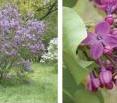Patriotic new lilacs introduced
Lilacs. The word evokes memories of promising spring days and visions of colorful, perfumed blooms. Lilacs have long been well-loved staples in America's yards and gardens, and have played a storied role in U.S. history. Native to East Asia and Southeast Europe, lilacs were brought to North America by the first settlers and were sold in American nurseries as early as 1800. The oldest living lilacs in North America may be those at the Governor Wentworth estate in Portsmouth, N.H., believed to have been planted around 1750. In 1767, Thomas Jefferson recorded his method of planting lilacs in his garden book, and in 1785, George Washington noted that he had transplanted lilacs in his garden. Today, over two million lilacs are sold annually in the U.S., accounting for over $13 million in wholesale sales.
The U.S. Department of Agriculture (USDA) recently developed and introduced three new cultivars of lilacs. Honoring the patriotic role lilacs have played in U.S. history, the new shrubs have been dubbed 'Betsy Ross', 'Old Glory', and 'Declaration'.
Dr. Margaret Pooler, a research geneticist at the USDA's Agricultural Research Service and U.S. National Arboretum, published a report in the April 2008 issue of HortScience, announcing the release of the new lilacs. According to Dr. Pooler, The National Arboretum's lilac breeding program was started in the 1970s to develop lilacs that were adapted to warmer climates, had good mildew tolerance, and a showy, fragrant floral display. 'Betsy Ross', boasting pale cream buds that emerge into pure white flowers, was released in 2000. 'Old Glory', and 'Declaration' were introduced in 2006. Both of the newer lilacs came from the same controlled hybridization, but have markedly different traits.
'Old Glory' was selected for its abundant fragrant bluish-purple flowers, rounded growth habit, and disease-tolerant foliage. According to Dr. Pooler, "In the Washington, DC, area, 'Old Glory' reaches a mature size of approximately 12 feet tall by 13 feet wide, and shows good tolerance to Cercospora blight and Pseudomonas syringae in warmer climates where these diseases are a problem."
'Declaration' was selected for its large, fragrant, dark reddish-purple flowers and open upright growth habit. In Washington, DC, its mature size is 8.5 feet tall and 7 feet wide; however, it performs best in traditional cooler lilac-growing regions. The names of all three cultivars were selected as part of a "U.S. Flag" series of lilacs from the National Arboretum. Both 'Declaration' and 'Old Glory' were tested by growers throughout the U.S. and are currently being propagated and should be available at retailers this year.
Source: American Society for Horticultural Science
Other sources
- Patriotic new lilacs introducedfrom Physorg16 years ago


